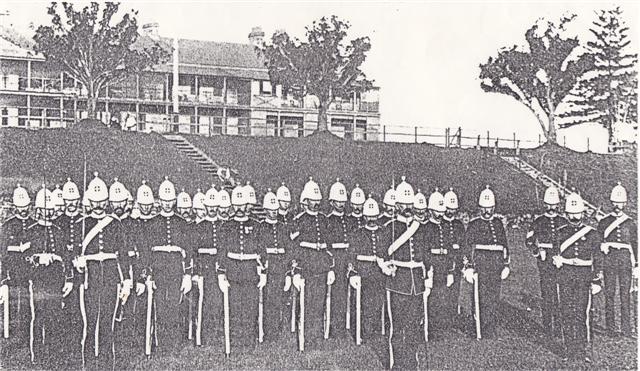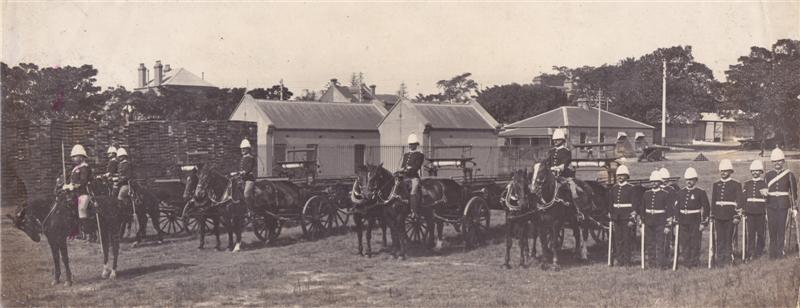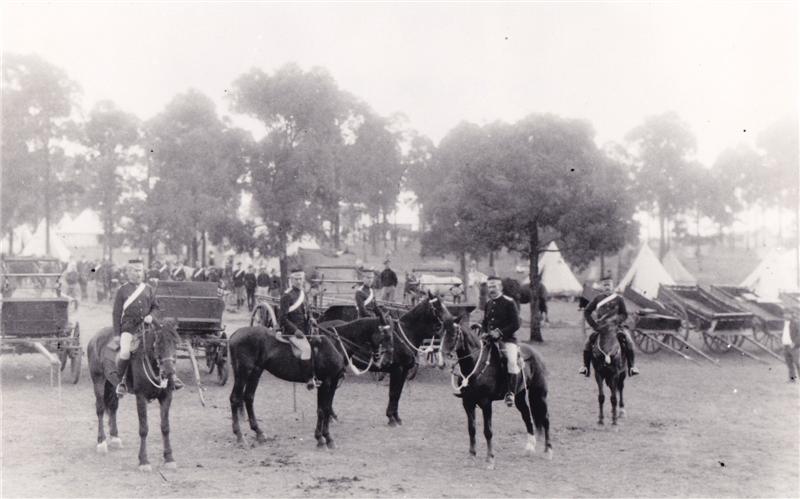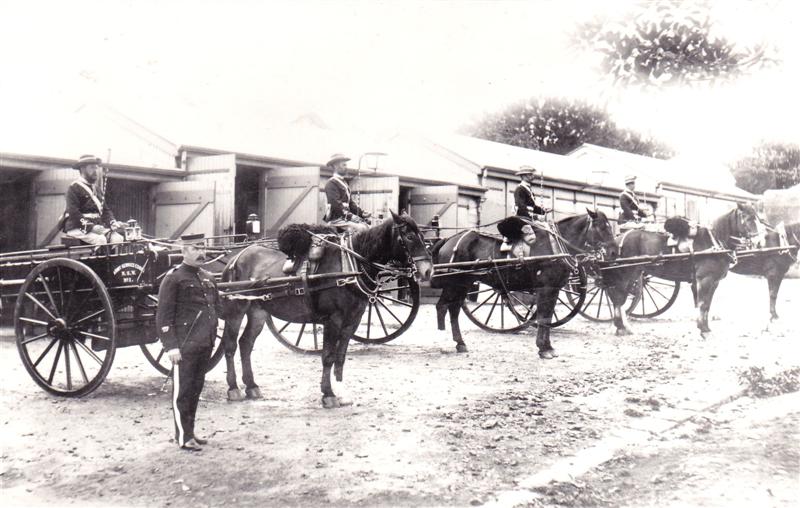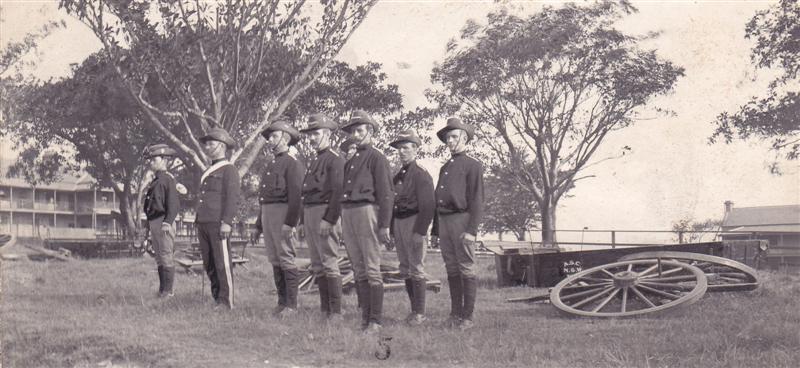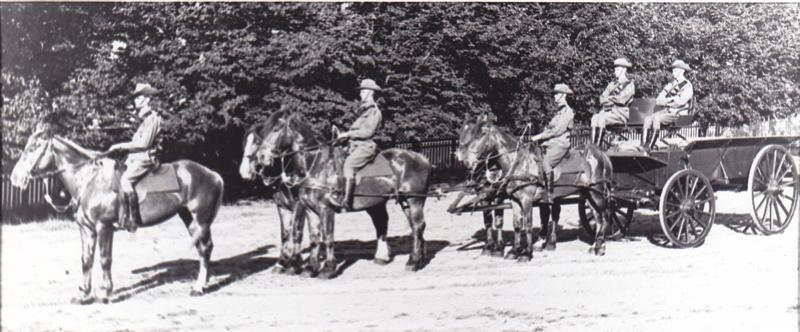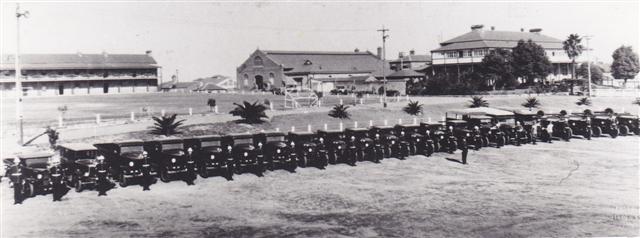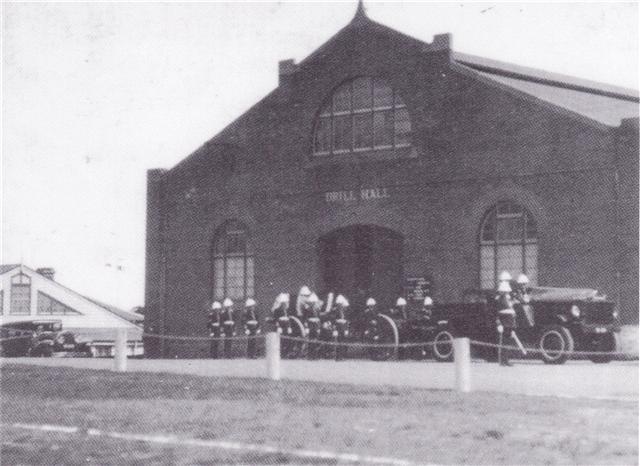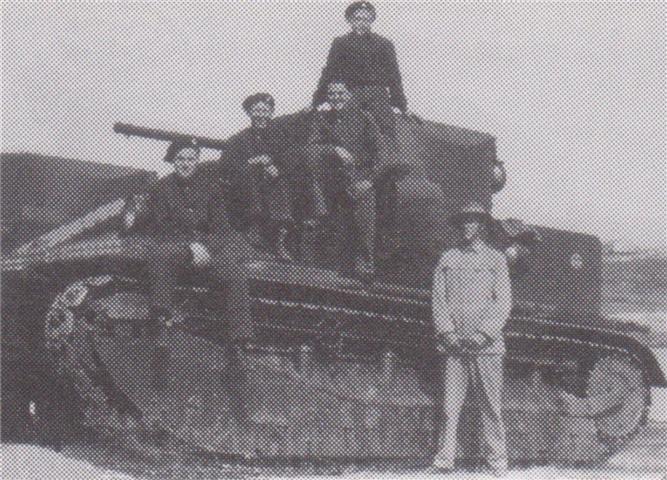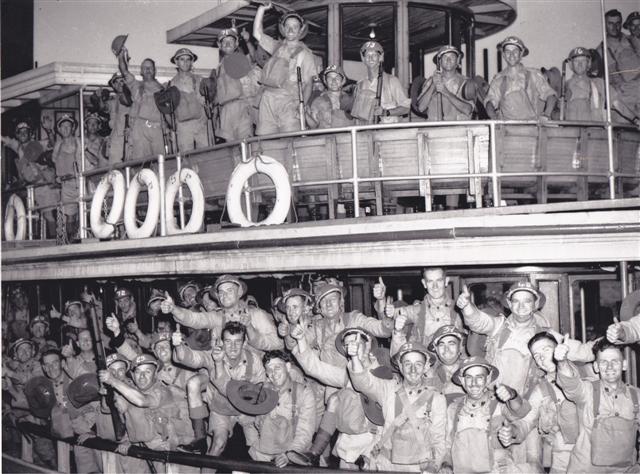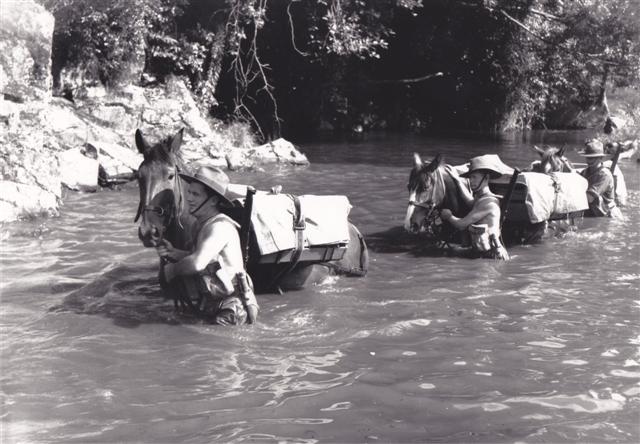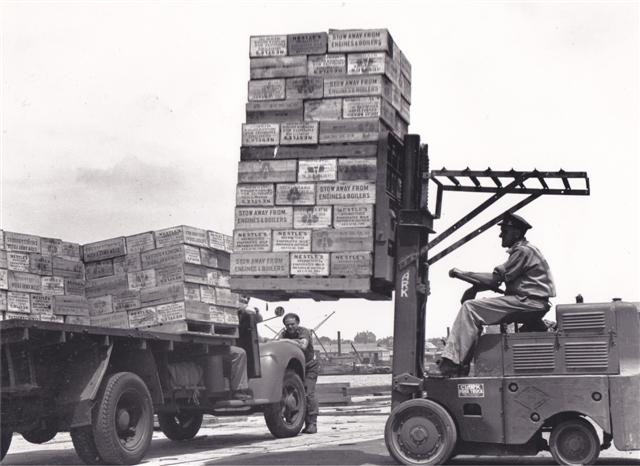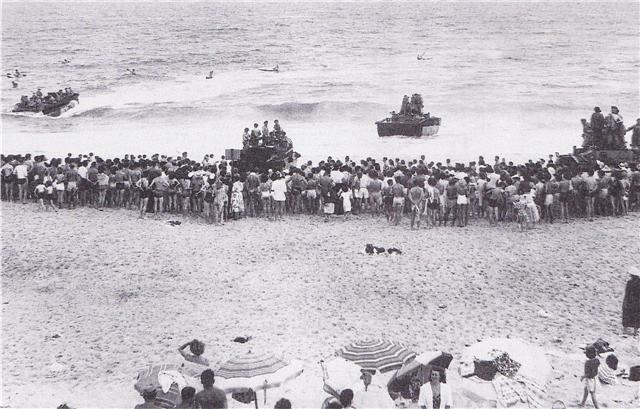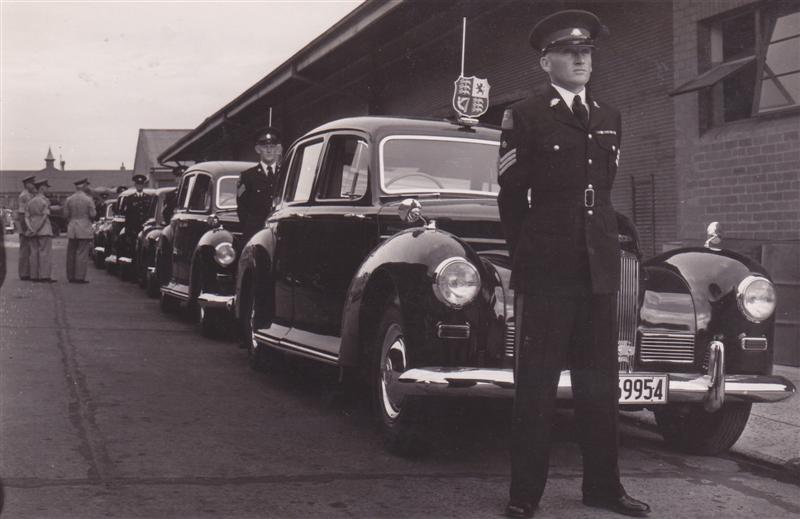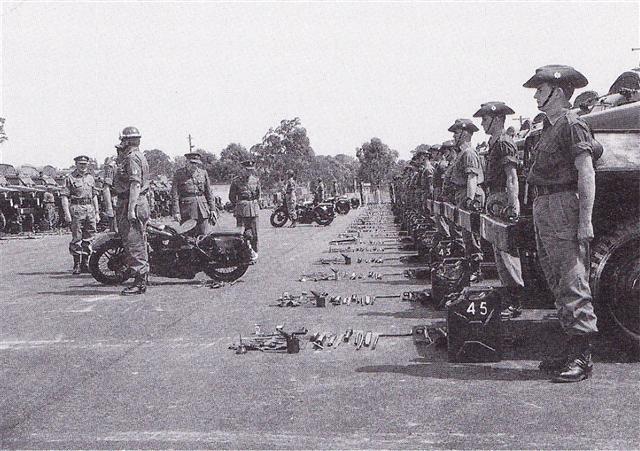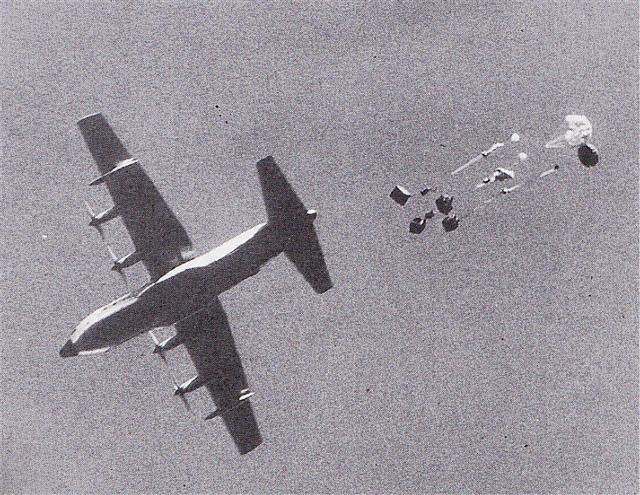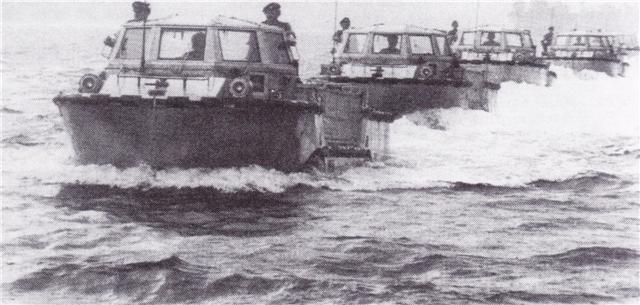Chapter 7
The Corps in New South Wales
NSW Commissariat and Transport Corps
New South Wales followed Victoria's lead by forming a Commissariat and Transport Corps in 1891 for the same reason – economy in support of Militia training camps. The commandant of the NSW Military Forces, Maj Gen J.S. Richardson, sometime commander of the NSW Contingent to the Suakin expedition, had commented two years before on the heavy costs of hiring transport and provision of supplies by local contractors as well as the general lack of military control over them. That opinion had been supported the same year by the report of an Imperial officer visiting as a result of the 1887 Intercolonial Conference, Maj Gen J. Bevan Edwards who recommended the formation of a Commissariat and Transport Corps 1, no doubt unaware that his own Army had, on fusing its two commissariat organisations a year earlier, renamed it the Army Service Corps. In his 1890 Defence Report, Richardson reported its process of formation and anticipated its 'rendering it possible to take the field with every branch in harmonious accord' 2.
In fact, the NSW Commissariat and Transport corps was not officially authorised until 1 January 1891, with a Militia strength of 39 comprising a captain, company sergeant major, three sergeants, three corporals, a trumpeter and 30 privates 3. The composition of the group makes it quite plain that the Corps was not organised to 'take the field' and that the other half of his Report was the operative one: 'a considerable saving per annum will be effected by the establishment of this Corps'. His 1891 report on the first year of operation acknowledges that it could not cope with even the training camp commitment, due partly no doubt to the fact that it had not been raised to full strength, but in 1893 a Royal Commission hit the nail on the head with the pronouncement that 'the system was only adapted for the requirements of the annual camp' 4.
Raising of the Corps, although begun well before its gazettal, does not seem to have progressed as the Commandant suggested. By the Easter Camp of 1891 its strength of 26 was within one of the initial target, but in the middle of the following year only half were classed as efficient 5. The reason for this is uncertain. Capt D. Miller who took command on the formation date was well enough reported on by Richardson then, and seems to have done well later, but these early years do not appear to be noteworthy for dynamic establishment, as was the Victorian Corps five years earlier; it may have been that the latter's technique of raising their Corps within existing artillery units and offering a 2/6 per day bonus was decisively better in recruiting and administering the new body, or simply that NSW had picked an inauspicious time, during the 1890s troubles when depression-inspired recruiting difficulties in Sydney paralleled those being then experienced in Melbourne.
Whatever the reasons for the slow start, its performance at the first camp at Campbelltown in 1891 was well enough received for 'far greater economy ... on dependable lines' compared with the system established under control of the State Commissary General; Richardson commended Miller for the efficiency of his command. The following year, the strength stood at 2 officers and 24 other ranks. Its pay rates ranged from captain £45, lieutenant £30 to private £12 per year, based on paid parades totalling 11 days; horses attracted £25, half the Victorian rate. A remarkable medical statistical summary for 1891 shows the Commissariat and Transport Corps as having the best physique of all units and corps of the Forces. As a foreshadowing of change, the title of ASC seemed to have gained unofficial currency from the beginning, appearing in General Orders as a realisation that an obsolescent title had been selected, based on Bevan Edwards' stumble 6. But formal change was less responsive.
For all Richardson's over-optimism on the progress of his forces, he was well aware of the deficiencies relating to putting them on a proper war footing. His staff was engaged on preparing a mobilisation plan which was given impetus from two directions – the Royal Commission on the Military Service and the arrival of his successor, Maj Gen E.T.H. Hutton, a veteran of three wars and an expert on mobile forces. While Richardson had been a friend of the family and worked by persuasion, the newcomer Hutton was blunt in his statement of the need for a revamp of the Army to fit it for the defence of the major centres by strong garrison troops, with a mobile field force free to concentrate where required. For this to be effective he needed a supplies and transport organisation capable of serving both wings of the force. The Commissariat and Transport Corps changed its title to Army Service Corps in recognition of its change to this role as much as catching up with the British jargon, and of a more tangible nature, its establishment increased to a permanent nucleus of nine, a Militia company of three officers and 57 other ranks, and for the future a Permanent adjutant/quarter-master and war establishment of six officers and 166 other ranks 7. At last some claim could be made that the ASC was being organised to take to the field.
The officer commanding became Major Miller, the adjutant/quartermaster 2Lt R.J. Beauman, a veteran of the Maori Wars, and the Corps was brought nearly up to strength at a total of 67. Six camps were supported at Liverpool, Bankstown, Wollongong, Bathurst, Moss Vale, Middle Head and South Head. An impetus had been imparted to the ASC by Miller, and the military forces in general by Hutton, who was able to end his tour of duty in 1896 with the claim of the Colony being unique in 'now possessing a small but complete military force, organised along the most modern lines’ 8.
His successor Maj Gen G.A. French, formerly Commandant of the Queensland Defence Force where he did not have the luxury of a supply and transport corps, was in no way critical of his inheritance, rather proposing incremental improvements including the raising of a second ASC Militia company to allow one for supply and one for transport 9. If he decided on this functional split on the advice of his ASC advisers he should have known better, as an officer who had war experience, that this missed the basic thrust of the supplies and transport concept learnt bitterly in war – that of keeping both functions together as a team, and one which his predecessor had emphasised. With the dispersed camps in peace and the separate formations to support in war, the functional companies would automatically have to be fragmented with a detachment from each in each location, causing consequent loss of unity of command and teamwork. This function-splitting in the face of hard won experience, which was to be repeated in the future, witnesses that there is no explaining the tidy mind which is comfortable with apparently neat pigeon holes rather than less geometrical but practical solutions.
French, keen on effectiveness and economy, concentrated the dispersed four day camps into a nine day one at Rookwood to fit more training time in between the march in-out procedures. This assemblage of 6,000 troops was a major test to which the ASC responded effectively, made significant savings in transport costs, rationalised foodstuffs contracts, and worked 14-hour shifts to meet demands made on it 10. As was also occurring in Victoria, the Corps was making a name for itself in getting the job done without counting the cost to itself, a performance which led to French reinforcing his demands for an increase in strength, and to the formation of the second company in 1899 11.
The Corps now stood at an authorised eight officers and 136 other ranks, comprising a headquarters staff of officer commanding and adjutant/quartermaster, No 1 Company and No 2 Company. It had in fact built up to an overstrength 147 as a preliminary to a further planned expansion which took effect at the end of 1900 when No 3 Company was raised by New South Wales and the bill passed to the incoming Federal Government 12. This fairly well developed structure also gave the Commonwealth Forces its only potentially effective ASC organisation which could be restructured with a minimum of effort back to the supplies and transport duality so necessary for field operational support.
This positive thrust by the NSW Forces into the Commonwealth arena kept the momentum going through the doldrums into which most other state forces slipped in the period from 1901 until after Hutton returned to Australia as GOC of the Commonwealth Military Forces in 1902. Under his plan of Commonwealth restructuring, the NSW ASC remained front runner, being reorganised into 1 and 2 LH Sup Cols for the light horse brigades and 1 Inf Sup Col for the infantry brigade, together with NSW Garrison Coy to support the garrison defence units and local details. The permanent cadre survived budget cutbacks with a small drop to 12 13. This head start plus the bonus of the permanent cadre ensured that the State retained a pre-eminence and priority in organisation, manning and equipment for the future which went beyond simple population advantage.
The Army in NSW, by retaining its essential structure from the Colonial Force, changed little. The AASC retained its blue dress uniform but used the Commonwealth 'universal' khaki as general duty dress, and continued its effectiveness as a going concern in support of training, with the benefit of its 30 GS wagons which represented most of the stock in the country. Its commander Capt (later Maj) R. Selwyn-Smith maintained a progressive approach by arranging courses in 1903 and 1905 for officers and senior NCOs to consolidate standards and prepare them for promotion. Camps were supported by 1 LH Sup Col at Casula, 2 LH Sup Col at West Maitland, 1 Inf Sup Col at Liverpool and NSW Garrison Coy in Sydney; by 1907 when the AASC in other Districts were learning to cope with basic camp support, 1 LH T&S Col was in the field supporting a mobile column exercising in the outskirts of Sydney 14. Maintaining this standard with only the minor change from supply columns to transport and supply columns in 1907 made for few problems until the reorganisation for Universal Training, and here again there was a bonus. While the Permanent staff in NSW was designated as the AASC training staff for all military districts, and its Capt M.McD. Lyons was also Inspector of AASC on the Commonwealth Inspector General's staff, their assistance to other Districts was during camp periods and the very odd course. The remainder of the time they were available to the NSW units and, in 1912 when no other AASC courses were conducted in Australia, 2 MD's throughput was 18 officers and 33 other ranks at this vital time of expansion 15. The transfer of Lyons to Victoria in 1913 was followed by the arrival of a seconded British ASC officer Lt S.G.Gibbs as ADS&T, district AASC instructor and national Inspector of AASC, providing both an element of continuity and a fresh approach, although his early absorption into the AIF makes his contribution hard to assess.
Once again, by working from a stable base, the NSW units had an even time in the expansion into the Universal Training brigade companies. While other states had had to raise extra Transport and Supply companies in 1911 during the lead up to the changeover, in NSW when the first 1912 Senior Cadet cohort arrived into the Militia, the three T&S Companies and Garrison Company were simply transmuted into 6, 7, 9, 25 and 26 Coys supporting respectively 6th, 8th, 5th, 2nd Light Horse and 3rd Light Horse Brigades; B Coy was raised in 1913 and 5 Coy in 1914, 5 and 25 Coys being based in Newcastle, the remainder in Sydney. The new scheme did add to the dispersion factor but not seriously, camps to support the decentralised training now extending to Pennant Hills, National Park, Armidale, Glen Innes and Goulburn, though in 1913 the number of companies available had still made it possible to keep 6, 7 and 9 Coys free for a combined camp at Scone to improve training in technical and tactical skills and prepare to hive off additional units. These properly prepared companies then supported the 1914 camps while the additional 4 and 8 Coys raised to meet the further influx from the Cadets were able to undertake their own bedding-in training 16. The changes were facilitated by a course programme to train the officers and NCOs required, the phased allotment of companies to the brigade camp support commitment, and the consequent room for training of new companies as they were raised. It all added to the model demonstrated by the AASC in NSW before and after Federation, of the value of planning ahead and so being able to take expansion and problems in its stride.
Training of the horsed army was also facilitated by raising a Remount Section and depots in 1911. The need for such an element had been recognised in the NSW Defence Force by establishing a Remount Depot in 1896, however this did not survive the 1903 Scheme of Organisation economies. When those economies were recognised as false ones, a section was re-established to operate from a depot at Holsworthy and sub depots at Newcastle and Moore Park. In that year nearly half of the 500 horses required were provided so successfully that the Section took over all government horses, but in so doing strained its personnel resources with a l:12 ratio instead of the planned 1:8. Plans were also begun to introduce a stud farm to stimulate breeding of the Waler line in the face of perceived deterioration of stock. Another aid to mobility was the use from the 1912 camps onwards of hired motor transport: not only were European armies adopting motorised columns but also the transport industry in Australia was beginning to replace horse conveyances with this obviously superior work-horse. Rather than hire wagons for extra camp transport, the AASC took the initiative and hired some lorries which showed their worth, but although acknowledged as successful by the Inspector General, it brought no response of a turn to motor transport. The only motor transport unit in the State was the NSW Section of the Australian Volunteer Automobile Corps, which attracted an initial half dozen starters in 1908, grew to sixteen by 1913, then dropped off to eight at the beginning of World War 1 as its members realised that their Corps was headed to a dead end 17.
The Militia at large was unaware that it also was heading to somewhat of a dead end brought on by the decision after the outbreak of war in August 1914 to raise expeditionary forces of volunteers rather than volunteer units. The first attempt at volunteering was for the ANMEF but ADS&T Gibbs refused to allow these to proceed as he was aware of the demands which were planned for the AASC AIF contingent for the war in Europe and considered the imperial priority greater than the Australian. As a populous state, NSW provided a heavy share of combat units and AASC units to match them. With the first convoy, of 1 Div Train the State shared 1 Coy with Victoria and provided 2 Coy, also adding an element of 10 Coy (1 Res Park, later of 5 Div Train). To the second convoy contingent was contributed 6 Coy (Z LH Bde Train), 7 Coy (4 Inf Bde Train, later of 4 Div Train), the railway element of 11 Coy, part of 8 Coy the motorised Divisional Ammunition Park, and an element of 13 Coy's field bakery and butchery. The 1915 contingents for Egypt included 15 Coy (5 Inf Bde Train, Iater of 2 Div Train), elements of 19 Coy's field bakery and field butchery, 21 Coy's 4 DUS and HQ and 5 and 6 Sqns of 2 Remount Unit; 24 Coy of 3 Div Train went direct to England in mid 1916, and the state also provided its quota for l, 2 and 3 Aux MT Coys in 1917. On top of all this was the continuing demand for reinforcements to provide extra men to both make up new units and to make good the losses which were not covered by reallocations overseas from other corps and the return to duty of rehabilitees in Egypt and France 18.
The main AIF training camp in the state was established at Liverpool, and the output of basic trainees from this was assembled into the AASC units at their camp at 'The Warren’, Marrickville. A familiar name reappears as commandant of all AIF camps in NSW – Col D. Miller CMG ISO who was recalled to the active list for this task. Supply and Transport support for the camps was provided by AIF AASC units and reinforcement groups in training or awaiting movement overseas, and home service members, augmented by Militia units and members on camps and additional duty: the Business Adviser's report on Business Branches of the Department of Defence for 1917 records the AASC 'alert and eager' at Liverpool Camp. An augmentation of this effort was the growth by stealth of a motor transport element, built up on gift cars, lorries and ambulances and a few purchases, manned by AIF home service and hired drivers. The essentiality of this group in keeping the AIF effort moving gained official recognition as 2 MD MT Depot, which carried through until well after the war 19.
Militia units continued their functions – the dual ones of integrating succeeding cohorts of Senior Cadets into the companies, and providing camp support to the training brigades. The seven companies of 1914 were augmented by 10 Coy at Sydney and 11 Coy at Bathurst in 1915, then remained static throughout the war as the influx was balanced by the progressive drain of volunteers for the AIF. The end of the war brought an end to the outflow and a consequent increase in the number of training brigades and therefore AASC companies, with an accompanying and unfortunate partial renumbering made all the more irrelevant as the company numbers rarely matched the brigades which they supported in camp. In 1919, 1 and 19 Coys were at Newcastle, 2 and 11 Coys at Bathurst, 6, 7, 15, 20, 24, 26 and 27 Coys at Sydney; and in 1920 the final disposition was 19 and 35 Coys at Newcastle, with all the others, 2, 3, 7,15, 20, 24, 26, 27, 32 and 33 Coys at Sydney 20.
Transfer of ADS&T Gibbs to the AIF as OC 12 Coy and subsequently as commanding officer of 2 Div Train left a gap which was filled first by Maj A.G. O’Donnell then from 1916 by Maj A.F. Tunks who had been the inaugural Officer commanding 2 Coy NSW ASC. The Military District staff was responsible for support of both AIF and AMF training camps plus technical instruction of AASC units. It also had to mount the massive local effort required in concentrating, accommodating, feeding, providing canteens and shipping the AIF contingents, from a zero base at a time when the most of its members with any experience were themselves volunteering and going overseas. From later in 1915, returning casualties from the front who were still fit for home service fleshed out this staff and balanced the attrition of officers and NCOs volunteering for the AIF, so the system managed to maintain the adequate level of support necessary for the ongoing training camps of the home army. This was in itself a periodically demanding task as, as well as helping out with the AIF training camps, there were occasional additional continuous training periods imposed on the Militia at large as the federal government sought to induce greater response to the call to serve overseas 21.
When the dust of demobilisation of the AIF had settled in 1921, the basis for the new Militia which mirrored the AIF settled three of the divisional trains in NSW: 1 Cav Div Train, 1 Div Train (less 4 coy of each located in Brisbane) and 2 Div Train. This ten company structure was well within the previous capacity, 19, 27 and 32 Coys converting to 1, 2 and 3 Coys of 1 Cav Div Train, 7, 15 and 35 Coys to 1 Div Train and 20,24 and 26 Coys to 2 Div Train. Manning was even more so when establishments were curtailed to 25 per cent of establishments for all units in 1922. That organisation continued until the progressive reorganisation to new RASC establishments from mid-1928 which saw the renaming of the Divisional Trains as Divisional ASC, an interim renaming of the l, 2, 3 and 4 Coys in each to A, B, C and D Coys, and the raising of a Depot Supply Section and a Horse Transport Company for each division. By 1930 the divisional companies and supply sections were consolidated into a single supply company for each division, giving an end structure of 1 Cav Div Sup Coy, 1 Cav Div HT Coy; 1 Div Sup Coy, 1 Div HT Coy; and 2 Div Sup Coy, 2 Div HT Coy, all transport being concentrated in the horse transport companies. When motorisation was on the horizon in 1934, the horse transport companies became 1 Cav Div MT Coy, 1 Div MT Coy and 2 Div MT Coy by virtue of each having three lorries added to their horse transport. A further halfway step to following war organisations came with the 1938 consolidation of the separate supplies and transport companies into supply columns and ammunition companies, with sections again farmed out to other States. The units were then 1 Cav Div Sup Coln (less C, F Secs in South Australia), 1 Cav Div Amn Coy, 1 Div Sup Coln (less C, D Secs in Queensland), 1 Div Amn Coy, 2 Div Sup Coln, and 2 Div Amn Coy 22.
Command of some of the units showed up one of the damaging effects of stagnant promotion in the between-war years which tended to feed on itself. Although the commanding officers who were in place at the beginning of the period were generally experienced and obviously successful commanders from the war, those who prolonged their tenure of office, at the expense of equally qualified juniors and compression all down the chain, began to outweigh the benefits of experience and continuity. While Blamey rightly commended the dedicated band of officers and NCOs who held the Army together during the depressed years, some senior officers did it to excess. In 1st Cavalry Division Lt-Col T.G. Millner MC held sway of the AASC for 10 years; in 1st Division and 2nd Division Lt-Col E.J. Munro DSO had a six year term in each, monopolising a total of 12 years, while Lt-Col E.O. Milne DSO took most of 2 Div AASC's remaining time for 10 years. No doubt these men thought that they were indispensable, but the firm post-World War 2 rule of a two year limit on command of units allowed a succession, gave incentive all the way down the line and coincidently demonstrated clearly that such a system worked if for no other reason that it forced the production of successors, rather than discouraging aspirants, as part of the officer training and management system. General Sir Ian Hamilton, on inspecting the Australian Army on the eve of World War 1, was enthusiastic on the quality of junior officers but commented bluntly on many of the commanding officers who had been around far too long; a weeding out process in the first AIF overseas was subsequently found necessary. It was fortunate for the World War 2 army that fresh officers had taken over in the late 1930s – Lt-Col L.J.A. Byrne in 1st Cavalry Division, Lt-Col J.H. Stevenson at 2nd Division and Lt-Col J.H. Hill commanding AASC units in 2MD 23.
The permanent section which had existed since pre-Federation remained after the war with its staff, Horse Transport Section and Remount Section as part of 2nd District Base. 2 DB HT Sec was located at Victoria Barracks Paddington and the Remount Section operated No 3, 4, and 5 Remount Depots at Holsworthy, Prospect and Moore Park. 2 MD MT Depot, deprived of its AIF element, lingered on at skeleton strength with hired drivers until withdrawal of funds in 1923 terminated motor transport. The 2 MD ADS&T position continued on to 2nd District Base, eventually filled in 1922 by Lt T.L. Huxtable until 1926, then Lt A.J. Stewart to 1927 and Capt C.B. Grieve MC to 1930 when Maj C.C. Easterbrook DSO MC took control until replaced briefly by Maj J.W. Shreeve then Capt A.R. Norris MBE MC until 1938; finally Lt-Col Millner filled the position until the war.
New positions of DADS and DADT(MT) established in 1927 were filled by Militia officers. On the MT side, the unreality of one lorry in 1925 gave way to 1 MT Sec, incorporating the artillery and engineer tractors as well at Victoria Barracks in 1930, expanded to 1 MT Coy in 1934, though staff supervision in the form of Maj A.J. Hamilton DSO was perhaps an overkill in the early stages. This was also the case with first Maj O.W. Rennick responsible for a section of a dozen vehicles, then Maj A.J. Stewart for a Company of 20 odd, but of course even such small numbers were a novelty since the end of the days when a captain commanded a company of 80 lorries in France and a major the 224 vehicles of the MT Service in England in 1918. 1 MT Coy also had under command 1 Tank Sect (later 1 Lt Tk Coy) at Randwick after its gunners and engineers were converted to AASC in 1932; the Company was renamed 2nd District MT Depot in the secondary expansion of 1938. Other elements of the expansion paralleling the MT one were the formation of 1 Sup Sec in 1934, absorbed in 1938 into a mostly Militia 5 Sup Pers Coy, also operating from Victoria Barracks. Additionally the Militia 2 MD Rmt Tp raised in the same year added to the capacity of the Remount section in opening sub-depots at Adamstown, Marrickville, Parramatta and Hurstville 24. A basic structure for mobilisation had begun to emerge.
World War 2 brought the raising of the Second AIF from volunteers rather than the volunteering of Militia units which had been swelled by the successful recruiting drive of 1938-39 in anticipation of the latter. Major elements of the AIF's eventual five divisions were raised in Eastern Command, initially on the basis of a four-brigade divisional structure which, under a genuine motorised regime, added a petrol company to the divisional AASC and now recognised the unavoidable corps troops slice for each division of an ammunition sub-park and a petrol sub-park. For the 6th Division, 6 Div Sup Coln was raised by Maj D.A. Nelson at Ingleburn in October 1939 from drafts assembled from the AIF camps at Ingleburn and Rutherford and from Queensland, being dispatched to the Middle East in January 1940; 6 Div Amn Sub-Park was not raised until December 1940, when it was assembled at Dubbo. HQ 7 Div AASC, raised by Lieut-Col H.M. Frencham in May 1940, embarked in October with its sub-units from other states; HQ 8 Div AASC with Lieut-Col L.J.A. Byrne as CAASC and 8 Div Sup Col were raised at Liverpool in July 1940 and left for Malaya in sections from February 1941; a core of HQ 9 Div AASC was raised in December 1941 and sent on to Palestine to join the elements being concentrated there from England and other formations; and 1 Armd Bde Coy, with a draft from Queensland, was formed for 1st Armoured Division in December 1941 25.
With the opening of hostilities E Comd Tps AASC was raised to provide the base infrastructure, entered camp and remained in training and support for two months. It was expanded into a Supply Wing comprising 1, 2 and 3 Sup Pers Coys and a Transport Wing of 2, 6, 12 and 13 Res MT Coys, 2 MD Bridge Coy, 3 and 4 VCC, 2 MAC and AASC Trg Depot. The mechanisation needs of both this minor increase and those of the forming AIF and Militia units were met by first hiring and in September 1940 the impressment of civilian vehicles, collected by 3 VCC and 4 VCC and prepared for issue by E Comd VRD. 2 Dist MT Dep was expanded, hiving off 2 Mech Dep, and DSD White Bay opened by the Supply Wing in February 1940 in hired warehouses to give a permanent supplies bulk issue backing to the field force supply columns and detail issue depots. After the initial period of extended camp training for the Militia divisions, they were given tasks as covering forces to protect the population and industrial heartland: Newcastle Covering Force and Sydney-Kembla Covering Force each with a HQ AASC, supply column, ammunition company and petrol company which were based at Victoria Barracks, then deployed after the outbreak of hostilities with Japan to Greta for the former, and the Iatter at Ingleburn. The HQ AASC and units of 1st Cavalry Division and 2nd Division were located at Cowra and Bathurst respectively. This structure remained in place until the reorganisation to the brick system in 1942, when the divisional AASC comprised 26:
HQ Comd 1 Div AASC |
13 Coy, 14 Coy, 15 Coy |
HQ Comd 2 Div AASC |
17 Coy, 18 Coy |
HQ Comd 10 Div AASC |
28 Coy, 29 Coy |
HQ Comd 1 Armd Div AASC |
1 Armd Div Tpt Coy |
HQ Comd 1 Mot Div AASC |
1 Mot Bde Coy |
Shortly after this 2nd Division moved to Western Australia and 10th Division was amalgamated with 1st Division, while 3rd Division and 3rd Armoured Division (raised from 1st Motor Division) trained in northern New South Wales and south east Queensland. Following the turning of the Japanese thrust in the Coral Sea and Papua, the threat receded and the divisions were wasted away but retained as shells which inflated the Order of Battle and wasted resources. NSW L of C Area's AASC function resolved itself into supporting the base infrastructure, training reinforcements, and acting as bulk supplier for the divisions actually training and fighting in the north.
In October 1942 supply of vehicles by AASC through hiring and impressment ended and the VCCs and VRD disbanded, all facets of vehicle procurement being assumed by MGO Branch and Ordnance depots. The remaining functions were AASC basic and technical training, the supply and transport support of local training and administrative facilities and the provision of base depots for the acquisition and dispatch to operational areas, lines of communication areas and local depots, of foodstuffs and petroleum products. Training was carried out by 2 AASC Trg Dep with 3 and 4 AASC Trg Coys, initially at Cowra then Goulburn in mid-1942; the Land HQ AASC School was transferred to Narellan in August 1945, and the LHQ Food Technology School operated at Randwick. General transport support was provided by 3, 4 and 5 Aux HT Coys in the Newcastle, Sydney and Western base areas, while the earlier galaxy of 102, 103, 106, 112, 113, 116, 117 and 118 Res MT Coys was converted to 114, 115, 116 and 117 GT Coys; 2 Amb Car Coy continued to provide casualty evacuation to the general and camp hospitals; and the remount units were consolidated into 2 Rmt Sqn in February 1942. 5 Pack Tpt Coy was raised and trained for employment in New Guinea in early 1944, but was already far too late for a theatre where air, ground and water supply techniques had been refined to a point where pack animals had become more an encumbrance than an aid.
NSW L of C Area BIPOD supplied petroleum products for the state, and for supplies DSDs operated at Werris Creek and Warrington-Goulburn with a BSD at Parkes; 2, 5 and 12 Sup Pers Coys operated detail issue depots at each of the myriad locations of training and prisoner of war camps, installations, training areas, hospitals and administrative areas, supported by detachments of 2, 3, 4 and 5 Fd Bkys and 2 Fd Bch Coy. In the 1943 brick reorganisation the depots and companies were reconstituted as 2 BSD and 16, 17, 18, and 19 Sup Dep Coys commanding 94-128 Sup Dep Pls. National depot facilities were centred on 1 SRD established at Lilyfield in May 1943 27.
This conglomeration of both transport and supply units was matched to the substantial and widely dispersed Army formations and infrastructure, necessary and unnecessary, in the State. Some of the members ardently wished to be serving in the operational areas to the north, others were returnees from there, medically suitable for base employment only, while again others were happy enough to remain in base areas. With Australia providing its own base support in the Pacific war such infrastructure was both novel and necessary, but to many it was not the reason they joined the war effort. While the standard of service provided was generally at the usual commendable levels, for many their commitments were less than obviously related to soldiering, and in some cases simply unrelated to the war. From slim beginnings the Army had mushroomed to meet a threat which then receded, but that recession was not matched by a commensurate reduction in overall structure until well after the event, leaving the AASC units with the ongoing task of maintaining support to an overinflated infrastructure in an environment which was increasingly isolated from an obvious connection with the fighting. It required strong direction from the L of C DDST Col G.A. Richardson and his staff, together with tenacity and dedication from those in the units to maintain the standards in this environment.
The Interim Army phase after disbandment of the AIF and full time duty Militia units left a residue of wartime units retained to provide minimum support to the remaining administrative commands and elements which were retained. Those retained for the new Australian Regular Army in 1948 were essentially base support units – 101 Tpt Coy and 102 Sup Pl, with 1 SRD retained as the national depot, and a detachment of 1 Tpt Coy at Ingleburn as part of an embryonic brigade group. Re-establishment of the CMF began with a modest group of HQ 2 Div Coln commanding 2, 3 and 4 Tpt Coys at Randwick, 1 Trk Amph Coy at Newcastle being corps troops and 1 Armd Bde Coy allotted to 1st Armoured Brigade at Parramatta. Gone were the expansive days of three divisions for New South Wales, or indeed seven for the whole field force. In an Army which had had to support itself recently in the Pacific the unavoidability of a balanced order of battle was recognised, and this meant that the planned allocation of resources not only to RAASC but also all other supporting arms afforded no more than the equivalent of three divisions within the 70,000 manpower allocation. But even then such known-to-be-essential units as petroleum, port, butchery, bakery, cold storage, air dispatch and motor ambulance were deferred for later attention 28.
That attention was made feasible in the expansion to accommodate the National Service system from 1951. such growth affected the Army as a whole, resulting in the raising of units in widely dispersed population centres to absorb locally the output of the basically trained men from the National Service training battalions during their five year Citizen Force training liability. But for some of the RAASC communication zone units this was not the case as their specialist nature meant that they had to be in the Sydney area to draw on the community's kindred trades and for adequate training facilities. During the build up, first HQ E Comd Tps RAASC then 9 Tpt Colm were raised to command the extra companies; then as these increased to a peak of 14, an additional HQ 1 Dist CRAASC was added. This large grouping lasted until the end of National Service in 1959 and return to a volunteer CMF, when the structure built on the influx of compulsory citizen soldiers became unsustainable, most of the companies, E Comd Tps and HQ 2 Div Coln being disbanded. As part of the new logistics structure HQ 1st Logistic Support Force was embodied to command corps troops and communication zone support units for a 1st Division now earmarked for SEATO operational deployments; its units were a mixture of Regular and CMB dispersed throughout the States. The remaining units were allotted to Headquarters Communication Zone and, as the reintroduction of National Service in 1963 started another increase in RAASC companies, 8 ST Colm was raised to command them 29. A snapshot of this see-sawing of units is shown in Table 7.
The Australian Regular Army presence was initially controlled by a carryover of the DDST staff on Headquarters Eastern Command which was the postwar replacement for NSW Lines of communication Area. This changeover in command was necessitated by the restoration of the Military Board which, having directional but no command authority, required commanders of the Army to replace the now defunct commander in chief and field commanders. The few Regular units mentioned earlier and the CMF units were trained and administered under this command, which included first a DDST, then a CRAASC staff. National Service did little for the ARA strength, other than to divert much of it to supporting and staffing the three National Service battalions; demands for more all arms drivers, clerks, storemen and cooks resulted in formation of E Comd Trade Trg Centre in 1952 30. A temporary special transport unit was formed for the visit of the Queen in 1954 – the Royal Visit Car Company, incorporating selected drivers from throughout the Corps. A similar unit had been formed in Victoria for the proposed visit of Princess Elizabeth in 1952, cancelled because of the death of the King. Now the unit reformed at Randwick and was notably successful in providing transport for the visiting Head of State plus the accompanying entourage throughout the States and Capital Territory, a feat of not just superior driving but superior management to meet schedules and transfers of the mammoth quantity of baggage involved. Its existence was not without resentment from within the Department of Supply and Transport’s VIP car fleet, but the organisational capacity in the Department was not adequate, and RAASC was given the task; however for the next royal tour the Department equipped itself with the Army files which showed how to do it, and thereafter it maintained a mortgage on that function 31.
There was little change in the structure of the units until a decision in 1957 to concentrate the bulk of the Regular 1st Infantry Brigade Group at Holsworthy-Ingleburn to train and prepare as a ‘ready reaction' force. Part of this concentration involved 1 Coy which was moved from Puckapunyal to Holsworthy where it was made up from HQ 1 Coy commanded first by Maj J.J. Spring then Maj D. White, 1, 2 and 3 Tpt Pls, 1 Comp Pl and 1 Tpt Coy Wksp RAEME. With the Regular strength still stretched by providing support staff to National Service and the expanded CMF units, manning of 1 Coy with fit and first quality young soldiers was always a difficult proposition, as anyone in that category found little difficulty in gaining promotion as an instructor with the former units. The difficulties of maintaining the company as a viable organisation provided a testing training ground for part of a generation of junior officers who later appeared on the staff and in command in Vietnam and Singapore: R.J. Darlington, P. M. Douglas, A.J. Corboy, B.R. Fegan, D.W. Ford, J.P Hunter, J.M. Neenan and L.A. Power.
Expansion of the force in Vietnam in 1966 required 1 Coy to move to Vung Tau to support both the Task Force and Logistic Support Group. 5 Coy was re-raised to replace 1 Coy at the end of its one year tour when it was returned to Holsworthy. A mixed Regular-CMF HQ CRASC 1 Div was raised, but it was not given a command function, being little more than an undermanned staff element of 1st Division's headquarters. 9 ST Colm and HQ 1 AASO were brought to Regular status to command the increasing full-time component of RAASC in the eastern states, though the units they did command were themselves at less than full strength, with sub-units distributed in other commands: 37 Sup Coy had 4 Sup Pl, with 52 Sup Pl in Queensland, 8 Sup Pl, 8 Pet Pl and 55 Fd Bky Pl in Puckapunyal; 25 Coy was at Puckapunyal and 18 Coy in Brisbane until it moved to Sydney in 1971. These outlying units were under command of the local Command and even area headquarters, and so the connection was ephemeral, a largely paper empire. But the base structure had a more solid basis, with HQ 101 Coy, 389, 390 and 391 Tpt Pls and 2 Sup Dep, 116 and 121 Sup Dep PIs supporting the training and administrative centres in Sydney, Holsworthy and Singleton, and E Comd Trade Trg centre providing the training support for the driving, clerical and cooking trades. The by the end of the decade- CRAASC Eastern Command Col I.H. Hayman had a large and disparate area of responsibility, complicated by the field force and area command arrangements which ensured that the principle of unity of command was well diluted, requiring the CRAASC to use informal substitutes to ensure that standards of training and service were maintained throughout the Corps units 32.
At the close of the era CRAASC Eastern Command Col J.A. Hallett became its Chief Transport Officer on 1 January 1973, taking on the removals and movements staffs and passing the supplies staff to Ordnance. Officiating at the disbandment parade at the Rose Bay flying boat terminal Sydney on 2 Jun 1973, the Governor of New South Wales Sir Roden Cutler together with a large crowd of well wishers said farewell to 82 years of unbroken tradition of service and passed the responsibility to the Royal Australian Corps of Transport.
Footnotes
1. V&P NSW LA 1888 Report for the Year 1888 on the NSW Military Forces by Maj Gen J.S. Richardson, p4; 1888 2nd Session vol I Report of Major General J. Bevan Edwards on the Proposed Organisation of the Military Forces of the Australian Colonies, p5.
2. V&P NSW LA 1891 Richardson Report, p5.
3. NSW Government Gazette 3 February 1891, p954.
4. V&P NSW LA 1892-3 vol VII Royal Commission Report, p30.
5. V&P NSW LA 1892-3 vol VII Richardson Report, p12; Royal Commission Report, p14.
6. V&P NSW LA 1892-3 vol 7 Richardson Report, p4-5; GO 194 /1891.
7. V&P NSW LA 1892-3 vol 7 Richardson Report, p10; 1894- 5 Hutton Report, p15; 1896 vol IV Hutton Report, p17; GO 254/93.
8. V&PNSW LA 1896 vol IV Hutton Report, p1.
9. V&P NSW LC 1897 vol VII French Report, p8.
10. V&P NSW LA 1898 2nd Session vol III French Report, p8.
11. V&P NSW LA 1900 vol IV French Report, p11.
12. The NSW Army and Navy List 1901, p113.
13. Appendix 3; CPP 1903 vol II Scheme of Organisation, p5.
14. CPP 1906 vol II Finn Report, p16; Holdsworth A.A. 'The Australian Army Service Corps' ASC Quarterly Aprll 1907, p161, 164; MO 16/1908, 79/1907.
15. MO 375/l9l0, 518/1911; CPP 1913 vol II Kirkpatrick Report, p20.
16. MO 428/1912, 650/1912, 555/1913.
17. V&P NSW LA 1896 vol IV Defence Report, p1; CPP 1920-1 vol IV Chauvel Report, para 108; 1911 vol II Kirkpatrick Report, p24; 1912 vol II Kirkpatrick Report, p17; Army List 1908, 1913, 1914 AVAC.
18. AWM 224 2 DRL 1160; Report upon the Department of Defence 1914-1917 Part 1, p73-4, 76.
19. Miller D. Standing Orders for AIF Camps; CPP 1914-17 vol II Synopsis of a Report on Business Branches of the Department of Defence, p11: Report on DOD, p276, 294-6.
20. MO 1/1915; 150/1919, 103/1920.
21. Report on DOD Part 1, p276.
22. CYB 1921-38; Army List 1921-38; AA MP729 /6 37/401/79 of 10 February 1938 Appendix Z.
23. Army List 1920-40.
24. AAO 401/1928; AA MP367/6 3l/1/132 Military Board Agenda 144/1924; Army List 1922-40; AA B1535 763/2/63 QMG on Military Board Agenda 2/32; AA MP729/6 QMG Minute of 10 February 1938.
25. AWM 52 10/2/23; AA MP 729/7 37/421/488, 37/421/447.
26. Par Oneri March 1940; Army ORBAT December 1941, October 1942-June 1943; AWM 54 199/2/5; AWM 52 10/2/16, 10/2/17, 10/2/25, 10/2/28, 10/2/30.
27. Army ORBAT October 1942-June 1943; AWM 54 199/2/5 Maintenance Organisation September 1941 Appendix A; 703/4/11 NSW L of C Area ORBAT 3 January 1944; 703/5/3 Army ORBAT 1944; AWM 52 10/35/1, 10/43/8.
28. AWM 54 703/5/1 Army ORBAT 1948; AWM 51 146 Army ORBAT 1948/49.
29. AA MP729/8 3/432/106 CMF Expansion 1951-56; Army ORBAT 1958.
30. Army ORBAT 1960, 1963; RAASC Digest 1967-71.
31. Interview R.R. Harding; RAASC Quarterly Bulletin No 1,5, 10, 14, 15; Thornhill C.E. The Royal Visit Car Company.
32. Interview D. White, J.P. Hunter, L.A. Power; Army ORBAT 1958, 1960, 1963; RAASC Digest 1967-71.
